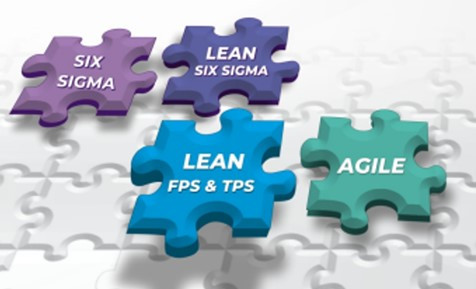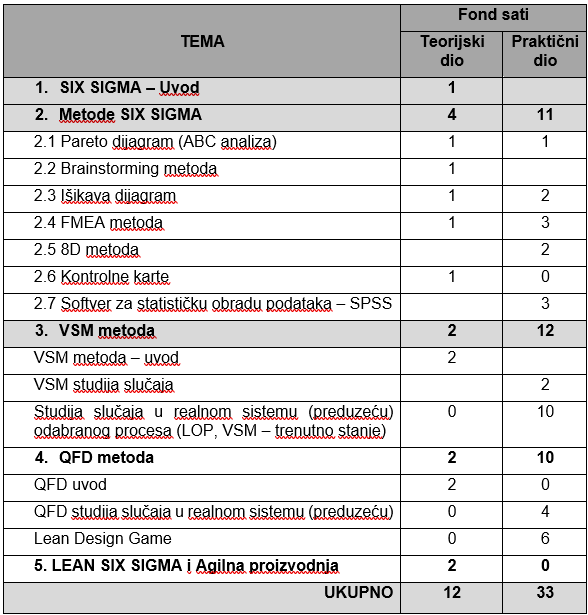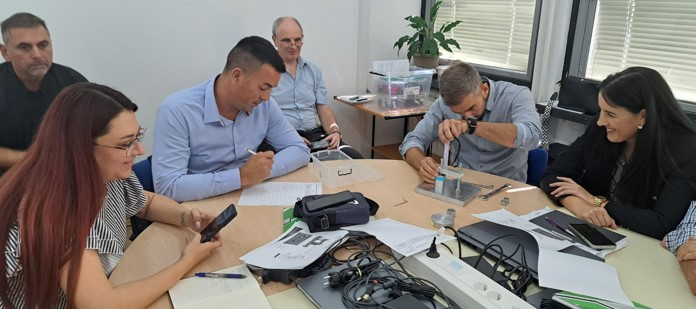
COURSE OBJECTIVES
This the course is designed to provide training in the application of Lean Six Sigma methodology designed to reduce wastage which appear in any who in shape at realization process, product or service. With studies case, course helps in building competence for efficient and effectively management business processes.
COURSE OUTCOMES
Participant course will be able to :
· explain Lean Six Sigma methodology and phases of the DMAIC (Define, measure, analyze, improve, control) model
· application certain statistical tools and measurement techniques and analysis performance process and reduction shortcomings and variability
· prepare map process using VSM tool (mapping flow values),
· identifies waste, narrow throats and potential areas improvements in observed processes
· benefits methods for analysis cause problems (e.g. using diagram fish bones or 5 Why) in real processes and suggest solutions to the goal prevention repetitions inconsistencies
· designs and application measures optimization improvements process in order to creation value for the customer,
· works in a team and independently leads projects improvements process.

Course realization:
Prof. Dr. Zorana Tanasić
Prof. Dr. Goran Janjić
CILJEVI KURSA
Ovaj kurs je osmišljen da pruži obuku u primjeni Lean Six Sigma metodologije dizajnirane da smanji rasipanja koja se pojavljuju u bilo kom obliku pri realizaciji procesa, proizvoda ili usluga. Uz studije slučaja, kurs pomaže u izgradnji kompetencija za efikasno i efektivno upravljanje poslovnim procesima.
ISHODI KURSA
Učesnik kursa će biti u stanju da:
– objasni Lean Six Sigma metodologiju i faze DMAIC (Definisanje, mjerenje, analiza, poboljšanje, kontrola) modela
– primjeni određene statističke alate i tehnike za merenje i analizu performansi procesa i smanjenje nedostataka i varijabilnosti
– pripremi mapu procesa pomoću alata VSM (mapiranje toka vrijednosti),
– identifikuje rasipanja, uska grla i potencijalne oblasti poboljšanja u posmatranim procesima
– koristi metode za analizu uzroka problema (npr. korišćenje dijagrama riblje kosti ili 5 Zašto) u realnim procesima i predloži rješenja u cilju sprječavanja ponavljanja neusaglašenosti
– dizajnira i primjeni mjere poboljšanja za optimizaciju procesa u cilju stvaranja vrijednosti za kupca,
– radi u timu i samostalno vodi projekte poboljšanja procesa.

Realizacija kursa:
Prof. dr. Zorana Tanasić
Prof. dr. Goran Janjić
- Предавач: Zorana Tanasic

Course objectives
The LEAN fundamental course is designed to provide participants with a comprehensive understanding of the principles and practices of the Lean concept. The goal of the course is for participants to master basic LEAN methods and tools that enable the acquisition of specific knowledge and skills to improve business efficiency and customer satisfaction.
Course outcomes
After completing the course, participants will be able to: understand the LEAN philosophy with the application of innovative learning methods; analyze production and service processes, recognize waste within them and, by applying appropriate LEAN methods and tools, influence the increase of their efficiency and effectiveness.
Plan and program for industry
|
TOPICS |
Hours |
|
|
Theoretical part |
Practical part |
|
|
1. LEAN concept - Introduction |
4 |
|
|
LEAN principles and the PDCA Cycle |
1 |
|
|
LEAN wastes |
1 |
|
|
LEAN methods and tools - LEAN house (JiT, Jidoka, Kaizen) |
2 |
|
|
|
|
|
|
2. 5S method |
2 |
3 |
|
5S method and examples from practice |
2 |
|
|
LEAN 5S Game: House construction with lego (Game idea designed by the University of Ljubljana) |
|
3 |
|
|
|
|
|
3. Kanban/ One piece flow/ Heijunka |
2 |
2 |
|
Concepts of the Kanban system |
2 |
|
|
Kanban case study |
|
2 |
|
|
|
|
|
4. Visual management |
2 |
|
|
5. JIDOKA - Poka Yoke/Andon |
1 |
|
|
6. Plant layout/ Spaghetti diagram |
2 |
|
|
7. Standardized Work |
1 |
5 |
|
Standardized Work - Introduction |
1 |
|
|
Preparation of Operator Instruction Sheet (OIS) - exercise |
|
2 |
|
LEAN Standardized work Game: Product assembly (with Lego) Designed by University of Ljubljana) |
|
3 |
|
|
|
|
|
8. SMED method |
2 |
4 |
|
SMED - Introduction |
2 |
|
|
SMED game (Designed by LEAN Management Academy) |
|
4 |
|
|
|
|
|
9. Total Productive Maintenance - TPM |
2 |
2 |
|
Total Productive Maintenance (TPM) - Introduction |
2 |
|
|
TPM case study (using SPSS software) |
|
2 |
|
|
|
|
|
10 Elaboration of LEAN methods through LEAN games - LEAN office game (Designed by KU Leuven) or Lean Activity Factory Game |
|
6 |
|
UKUPNO |
18 |
22 |
Course realization:
Prof. Dr. Zorana Tanasić
Prof. Dr. Goran Janjić
Ciljevi kursa
Osnovni LEAN kurs (LEAN fundamental Course) je dizajniran da pruži učesnicima sveobuhvatno razumijevanje principa i praksi Lean koncepta. Cilj kursa je da učesnici ovladaju osnovnim LEAN metodama i alatima koje omogućavaju sticanje specifičnih znanja i vještina za poboljšanje efikasnosti poslovanja i zadovoljstva kupca.
Ishodi kursa
Po završavanju kursa, učesnici će biti osposobljeni da: uz primjenu inovativnih metoda učenja razumije LEAN filozofiju; analiziraju proizvodne i uslužne procese, prepoznaju rasipanja unutar njih i primjenom odgovarajućih LEAN metoda i alata utiču na povećanje njihove efikasnosti i efektivnosti;
Plan i program za industriju
|
TEMA |
Fond sati |
|
|
Teorijski dio |
Praktični dio |
|
|
1. LEAN concept - Uvod |
4 |
|
|
LEAN Principi i PDCA ciklus |
1 |
|
|
LEAN rasipanja |
1 |
|
|
LEAN metode i alati - LEAN kuća - Kaizen |
2 |
|
|
|
|
|
|
2. 5S metoda |
2 |
2 |
|
5S metoda i primjeri iz prakse |
2 |
|
|
LEAN 5S Game (House construction with lego, igra dizajnirana od strane Univerziteta u Ljubljani) |
|
2 |
|
|
|
|
|
3. JIT/ Kanban/ One piece flow/ Heijunka |
2 |
2 |
|
Koncepti Kanban sistema |
2 |
|
|
Kanban studija slučaja |
|
2 |
|
|
|
|
|
4. Vizuelno upravljanje - Visual management |
2 |
2 |
|
5. JIDOKA - Poka Yoke/Andon |
1 |
|
|
6. Plant layout/ Špageti dijagram |
2 |
|
|
7. Standardizacija rada |
1 |
5 |
|
Standardizacija rada - Uvod |
1 |
|
|
Izrada Uputstva za operatera - Vježba |
|
2 |
|
LEAN Standardized work – Igra (Proces sastavljanja proizvoda uz pomoć Lego), Igru dizajnirao Univerzitet u Ljubljani |
|
3 |
|
|
|
|
|
8. SMED metoda |
2 |
4 |
|
SMED - Uvod |
2 |
|
|
SMED igra (SMED game, igra dizajnirana od strane LEAN Management Academy) |
|
4 |
|
|
|
|
|
9. Total Productive Maintenance - TPM |
2 |
1 |
|
Total Productive Maintenance – TPM - Uvod |
2 |
|
|
TPM studija slučaja |
|
1 |
|
|
|
|
|
10. Elaboracija LEAN metoda kroz LEAN igre - LEAN office game (Igru dizajnirao KU Leuven) |
|
6 |
|
UKUPNO |
18 |
22 |
Realizacija kursa:
Prof. Dr. Zorana Tanasić
Prof. Dr. Goran Janjić
- Предавач: Goran Janjic
Creating a Lean Culture addresses a gap in the literature on lean production and the Toyota Production System (TPS). This course introduces a lean system for management, first in concept and then in concrete detail. Lean management is a crucial ingredient for successful lean conversions. Yet, the standard books on lean either don’t cover it or only hint at implementing new ways to manage in a lean environment. Creating a Lean Culture provides the rationale and then a practical guide to implementing the missing link you’ll need to sustain your lean implementation— a lean management system. Lean production, based on the much admired Toyota Production System, has proved to be an unbeatable way to organize production operations. The key concepts of lean are easily grasped, and relative to most technical engineering projects, lean designs are easily implemented. Yet the majority of attempts to implement lean production end in disappointing outcomes, and declarations like: “Lean won’t work here,” or “with our people,” or “in our industry,” or “with our product/process,” and so on.
The purpose of lean management is to sustain a lean production system. Without a lean management system, lean production implementations often falter, sometimes fail, and virtually never deliver up to their long-run promises. This course lays out the components of lean management, how they work together, and how to implement the process. Creating a Lean Culture maps a course for leaders implementing lean management to guide them through the cultural minefields in batch-to-lean conversions.
Objectives:
- Understand the essential features and benefits of Lean management;
- Gain hands-on experience with five high-value Lean management techniques;
- Recognize how these five techniques make up a basic Lean management system;
- Learn the three critical concepts of process, waste and flow;
- Begin to break the dysfunctional habits of micromanagement and “workaroundism”;
- Discover ways of building a trusting and respectful culture;
- To highlight different techniques of Lean implementation;
- Предавач: Arjan Tushaj
PREDAVAČ
prof. dr Dušanka Bošković
CILJ/AIM
Ovaj modul uvodi polaznike u područje istraživanja korisničkog iskustva (UX). Naučit će primijeniti temeljne UX koncepte, poput dizajna usmjerenog na korisnika, ali uravnoteženo za agilni razvoj proizvoda - Lean UX: povezivanje UX-a s dizajnerskim razmišljanjem i agilnim pristupom.
This module introduces learners to the field of UX research. They will learn to apply foundational UX concepts, like user-centered design, but balanced for the Agile product development - Lean UX: linking UX with Design Thinking and Agile.
SADRŽAJ/CONTENT

- Предавач: Aleksandra Nikolic
PREDAVAČ
prof. dr Aleksandra Nikolić
CILJ/AIM
Cilj ovog studentskog kursa je istaći važnost stalnog unapređenja, kao mehanizma za identifikaciju i otklanjanje svih vrsta rasipanja i svih vrsta neefikasnosti u okviru poslovnog sistema.
U sklopu kursa bit će prikazane opšte postavke Lean pristupa kao moćnog sredstva za optimizaciju poslovanja, a posebno unapređenje praksi finog terminskog planiranja (KANBAN) što je osnov uspješnog timskog rada, mogućnosti samoevaluacije i uočavanja načina za poboljšanje svih radnih aktivnosti.
Dodatno, bit će objašnjena mogućnost da Lean pristup bude korišten platforma za primjenu drugih modela unapređenja, a posebno „ozelenjavanja“ poslovanja, te aplikaciju metoda Agilnog upravljanja, kao i mogućnost korištenja Lean pristupa kako bi „produbili“ digitalnu transformaciju, odnosno primjenu novih tehnologija.
The goal of this student course is to emphasize the importance of continuous improvement as a method for identifying and eliminating waste and inefficiencies within business systems.
During the course, we will introduce the general principles of the Lean approach, which serves as a powerful tool for optimizing business operations. In particular, we will focus on enhancing the practice of short-term planning using KANBAN, which is fundamental for successful teamwork and facilitates self-evaluation and the identification of opportunities for improvement in all work activities.
Additionally, we will discuss how the Lean approach can serve as a foundation for implementing other improvement models, particularly in the context of "greening" businesses and applying Agile management methods. We will also explore how Lean can further support digital transformation through the integration of new technologies.
SADRŽAJ/CONTENT
1. Permanentno unapredenje osnov poslovnog uspjeha i smanjenja negativnog impakta na okoliš i društvo / Permanent improvement is the basis for business success and reducing negative impact on the environment and society.
2. LEAN pristup optimizaciji i permanentnom unapređenju / LEAN approach to permanent improvenment
3. Zeleni i LEAN pristup poslovanju / Green and LEAN approach
4. KANBAN – fino, terminsko planiranje i timski rad/ scheduling and teamwork
- Предавач: Aleksandra Nikolic
This course provides a comprehensive overview of facility layout planning, a core component of operations management that significantly influences efficiency, workflow, and organizational performance. The layout of physical spaces whether in manufacturing plants, service centers, offices, or retail environments directly impacts productivity, safety, and communication.
Students will learn to analyze, design, and optimize layouts based on the nature of the operation, from product-based (assembly line) to process-based (functional), and explore the emerging relevance of hybrid layouts that combine flexibility with structure. The course emphasizes that layout planning is not only essential during the design of new facilities but also during expansions, upgrades, or organizational changes. Through theoretical frameworks, real-world case studies, and hands-on exercises, learners will develop the skills to align layout design with strategic goals, employee well-being, and operational excellence.
By the end of this course, participants will be able to:
- Define facility layout planning and explain its strategic importance in operations management.
- Identify and describe various types of layouts, including product, process, fixed-position, and hybrid layouts.
- Compare and contrast product layouts (linear, repetitive workflows) and process layouts (functional, flexible operations).
- Understand and apply the steps in designing process and product layouts using practical tools.
- Analyze when and how to use hybrid layouts for complex or dynamic operational needs.
- Evaluate how layout planning integrates across functions within an organization—from HR to logistics and supply chain.
Topics to be included:
· What Is Layout Planning?
· Types of Layouts
· Designing Process Layouts
· Special Cases of Process Layout
· Designing Product Layouts
· Facility Layout within OM: How It All Fits Together
· Facility Layout across the Organization
- Предавач: Brunilda Kosta
Lean Manufacturing and Quality Management Tools for Team-Based Problem Solving - COURSE FOR STUDENTS
The goal of this course is to provide a comprehensive overview of Lean Manufacturing principles and key Quality Management tools, with a focus on teamwork and continuous improvement. Through practical methods such as ABC analysis and scatter plots participants will be equipped to improve some operational efficiency, reduce waste, and enhance process quality.
- Предавач: Jelena Sakovic Jovanovic
This course provides a comprehensive overview of Lean Manufacturing principles and essential Quality Management tools. Focusing on teamwork and continuous improvement, students will learn practical methods such as brainstorming, Ishikawa (Fishbone) diagrams, ABC analysis, Scatter plots, Critical Path Method (CPM), PERT analysis… By combining lean tools and quality management techniques, participants will be prepared to drive operational efficiency, reduce waste, and enhance overall quality of processes.
Through interactive workshops and group exercises the course empowering participants to apply these methods in real-world settings to support Lean and Quality Management goals.
- Предавач: Jelena Sakovic Jovanovic
This course provides an overview of lean management principles and additive manufacturing (technologies, materials, equipment and design rules) with focus on application of lean approach to additive manufacturing. Special attention is devoted to the role of additive manufacturing in terms of reduction of the seven wastes (waiting and lead time, overproduction, over processing, transportation, motion, inventory and defects), as well as, in further waste reduction through light weighting, reduced scrap rate, reduced pollution, reduced CO2 footprint and energy-efficient parts.
Through practical exercises the course participants will be trained to apply lean approach to additive manufacturing and fabricate products by FDM and SLA additive manufacturing technologies in accordance with waste reduction principles.
- Предавач: Janko Jovanović
Mastering the possibilities of applying the lean approach in additive manufacturing. Training the use of CAD and slicer software for the preparation of 3D product models for additive manufacturing and the use of FFF/FDM 3D printers.
- Предавач: Janko Jovanović
